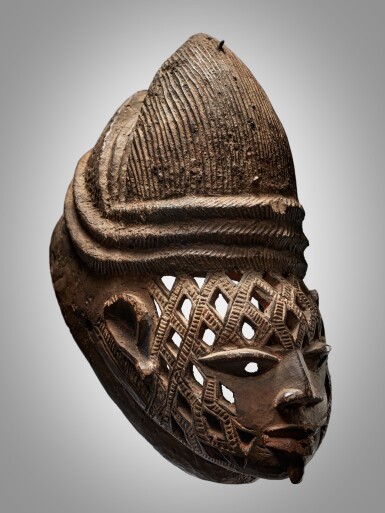Art of Africa, Oceania, and the Americas
Art of Africa, Oceania, and the Americas

Property from an American Private Collection
Yoruba-Nago Helmet Mask, attributed to Arobatan, Pobè, Republic of Benin
Lot Closed
November 22, 07:58 PM GMT
Estimate
100,000 - 150,000 USD
Lot Details
Description
Yoruba-Nago Helmet Mask, attributed to Arobatan, Pobè, Republic of Benin
Height: 12 1/2 in (31.8 cm)
Lance Entwistle, London
American Private Collection, acquired from the above in 1995
Gérald Berjonneau and Jean-Louis Sonnery, eds, Chefs d’œuvre inédits de l’Afrique noire, Boulogne, 1987, p. 149, cat. no. 107
Gérald Berjonneau and Jean-Louis Sonnery, eds, Rediscovered Masterpieces of African Art, Boulogne, 1987, p. 149, cat. no. 107
Gérald Berjonneau and Jean-Louis Sonnery, eds, Onbekende meestetwerken uit zwart Afrika, Tielt, 1987, p. 149, cat. no. 107
Henry John Drewal, John Pemberton III, Rowland Abiodun, Yoruba: Nine Centuries of African Art and Thought, New York, 1989, p. 220, fig. 258
Ezio Bassani, ed., La grande scultura dell’Africa Nera, Florence, 1989, p. 135, pl. 60
Lorenz Homberger, ed., Rowland Abiodun, Henry John Drewal, and John Pemberton III, Yoruba. Kunst und Ästhetik in Nigeria, Zurich, 1991, p. 31, cat. no. 37
Lorenz Homberger, ed., Rowland Abiodun, Henry John Drewal, and John Pemberton III, Yoruba: Art and Aesthetics, New York and Zurich, 1991, p. 31, cat. no 37
Ezio Bassani, ed., Le grand héritage. Sculptures de l’Afrique noire, Paris, 1992, p. 164, cat. no. 164
Christiane Falgayrettes-Leveau, Masques, Paris, 1995
Christiane Falgayrettes-Leveau and Iris Hahner, Parures de tête / Hairstyles and Headdresses, Paris, 2004, p. 200
Ekpo Eyo, Masterpieces of Nigerian Art, Abuja, 2008, p. 166, cat. no. 121
Jonathan Fogel, Polly Nooter Roberts, and Nancy Thomas, “The Inner Eye: Vision and Transcendence in African Arts”, Tribal Art, No. 84, Summer, 2017, p. 87, fig. 6
The Center for African Art, New York, Yoruba: Nine Centuries of African Art and Thought, September 21, 1989 – January 7, 1990; additional venues: The Art Institute of Chicago, February 10 – April 1, 1990; The National Museum of African Art, Smithsonian Institution, Washington, D.C., May 8 – August 26, 1990; The New Orleans Museum of Art, January 11 – March 24, 1991; The High Museum of Art, Atlanta, April 23 – June 16, 1991; The Cleveland Museum of Art, September 26 – December 9, 1991
The Los Angeles County Museum of Art, The Inner Eye: Vision and Transcendence in African Arts, February 26 - July 9, 2017
Carved with remarkable detail and skill, this gelede mask is possibly attributed to the sculptor Arobatan, from Pobè in the Republic of Benin, in southwestern Yoruba territory. The openwork, crosshatched composition of the face is immediately striking and highlights the mastery of the artist. This gelede mask is “a dramatic visualization of the ambiguities of masking, as it simultaneously reveals and conceals the identity of the wearer in the wonderful openwork carving of the face […] We see, and ‘see through’ [the artist’s] illusion of transformation – the male masquerade is at the same time not male and not not male, not female and not not female” (Christiane Falgayrettes-Leveau and Iris Hahner, Parures de tête / Hairstyles and Headdresses, Paris, 2004, p. 201). The elegant and elaborate coiffure on the top of the head as well as the plug on the lower lip suggest that this mask represents an important and respected female member of society, possibly a royal wife or a priestess. Remnants of red and blue pigments on the surface of the mask attest to its significant age and use.
Following the methodologies established in ancient Greek and Medieval art history, the identification of work by an artist or workshop is based on stylistic and contextual evidence. Often, names of convenience are used when the artist's actual name remains unknown. In the study of the history of African Art, the notion of the individual artist was not introduced until 1935 when Hans Himmelheber identified nineteen artists from Côte d'Ivoire in his groundbreaking Negerkünstler. Two years later, the Belgian art historian Frans Olbrechts identified a body of work created by “The Master of the Long Face of Buli”, referring to the now-famous Luba carver active in the 19th century. Subsequently, the identification of authorship and workshops has become an increasingly important focus of African art history. Yoruba kingdoms have a long history, dating to the nineteenth century and earlier, of master carvers, each with their own distinctive and highly refined style. An artist would typically teach his skills to his son, who in turn would often synthesize the learned styles and motifs to produce new, hybrid visions.
